1. Overview
Friedrich "Fritz" Kreisler (February 2, 1875 - January 29, 1962) was an Austrian-born American violinist and composer, widely regarded as one of the most influential and greatest violin masters of his era. He was celebrated for his distinctive musical style, characterized by a sweet, warm tone, expressive phrasing, continuous vibrato, and a unique blend of portamento and rubato, which made his sound instantly recognizable. Kreisler's significant contributions to classical music include a rich repertoire of original compositions, such as the beloved "Liebesfreud" and "Liebesleid," as well as his innovative approach to arranging and performing works by other composers. He also gained notoriety for his "musical hoaxes," where he attributed his own compositions to earlier masters, sparking both controversy and a renewed interest in Baroque music. His legacy continues to profoundly influence violin performance and repertoire worldwide.
2. Biography
Fritz Kreisler's life was marked by prodigious musical talent, a brief but impactful military career, and a lifelong dedication to music, despite personal challenges and global conflicts.
2.1. Early Life and Education
Kreisler was born in Vienna, Austria-Hungary, on February 2, 1875, to Anna (née Reches) and Samuel Kreisler, a doctor. Although of Jewish descent, he was baptized at the age of 12. His father, an enthusiastic amateur string player, encouraged his musical inclinations, and Fritz began learning the violin at the tender age of three. His exceptional aptitude led to his enrollment as a special case at the Vienna Conservatory between 1882 and 1885. There, he studied violin under Jakob Dont and Joseph Hellmesberger Jr., and composition under Anton Bruckner. While at the conservatory, he had the opportunity to hear performances by renowned masters like Joseph Joachim, further refining his musical sensibilities.
At the age of 10, Kreisler graduated from the Vienna Conservatory with top honors. He then continued his studies at the Paris Conservatory from 1885 to 1887, where his teachers included Léo Delibes, Lambert Massart, and Jules Massenet. He graduated from the Paris Conservatory at the remarkably young age of 12, earning the "Premier Prix" gold medal, competing against 40 other violinists, all of whom were at least 20 years old.
2.2. Early Career and Setbacks
Kreisler made his United States debut at Steinway Hall in New York City on November 10, 1888, followed by his first U.S. tour in 1888-1889 with pianist Moriz Rosenthal. After this initial success, he returned to Austria. Influenced by his father, who did not wish for him to be merely a child prodigy, Kreisler pursued a general education, including a brief period of studying medicine, though he found it did not suit him.
In 1895, he joined the Austro-Hungarian Army, serving in the Imperial Guard and being commissioned as a reserve officer. He even considered a military career, temporarily abandoning the violin. However, due to family circumstances, he was discharged and returned to music in 1899. During this period, he faced a notable setback when he applied for a position in the Vienna Philharmonic but was rejected by concertmaster Arnold Rosé, who reportedly deemed his playing "musically crude" and his sight-reading "unskilled." This rejection did not deter him.
His return to the violin was marked by a concert with the Berlin Philharmonic conducted by Arthur Nikisch in 1899. This performance was highly praised, notably by Eugène Ysaÿe, and marked the turning point in his career. A series of American tours from 1901 to 1903 further solidified his reputation, bringing him widespread acclaim. He also made his London debut in 1902, establishing England as his base for a period and beginning his recording career around this time.
2.3. Marriage and Personal Life
During a concert tour of the United States in 1901, Kreisler met Harriet Lies, a New York-born divorcée and Vassar College graduate, whose father was a German-American tobacco merchant. They fell in love quickly and married a year later in New York in the winter of 1902, though they repeated the ceremony three more times due to legal technicalities. The couple had no children.
Harriet devoted her life entirely to managing Kreisler's career. She understood his temperament and musical genius, acting as a capable and shrewd manager. She meticulously controlled his daily life, ensuring he practiced diligently by keeping him confined to his room until scheduled times. Externally, she skillfully negotiated concert fees and maintained a discreet presence during performances, waiting backstage without interfering. Her unwavering support and astute management were instrumental in his artistic and professional success. Their marriage lasted for 60 years until his death in 1962.
2.4. World War I and Citizenship
In 1910, Kreisler premiered Edward Elgar's Violin Concerto, a work commissioned by and dedicated to him. With the outbreak of World War I in 1914, Kreisler was recalled to military service as a lieutenant in the Austro-Hungarian Army. He served briefly on the Eastern Front but was honorably discharged after sustaining a serious injury. He arrived in New York on November 24, 1914, and remained in the United States for the duration of the war, as Austria was an enemy nation. During this time, he donated money from his performances to support wounded soldiers.
After the war, in 1924, he returned to Europe, residing first in Berlin. However, with the rise of Nazism in Germany, Kreisler, being of Jewish descent, resolutely refused calls to remain in Germany, despite his popularity. In 1938, following the Anschluss (annexation of Austria by Nazi Germany), he acquired French citizenship and moved to Paris. As World War II loomed in 1939, he decided to permanently settle in the United States, becoming a naturalized citizen in 1943. He never returned to Europe after this.
2.5. Later Life and Health
Kreisler spent the remainder of his life in the United States. On April 26, 1941, he was involved in a serious traffic accident in New York City, where he was struck by a truck while crossing a street. He suffered a fractured skull and was in a coma for over a week. Although initial reports suggested he might not recover, he made a miraculous comeback.
In his later years, Kreisler experienced declining health, including significant hearing loss and vision deterioration due to cataracts. He also suffered from occasional memory loss, though his musical sense remained miraculously unaffected. He gave his last public concert in 1947 and continued to broadcast performances for a few years thereafter.
Fritz Kreisler died of a heart condition aggravated by old age in New York City on January 29, 1962, just days before his 87th birthday. He was interred in a private mausoleum in Woodlawn Cemetery in the Bronx, New York City.
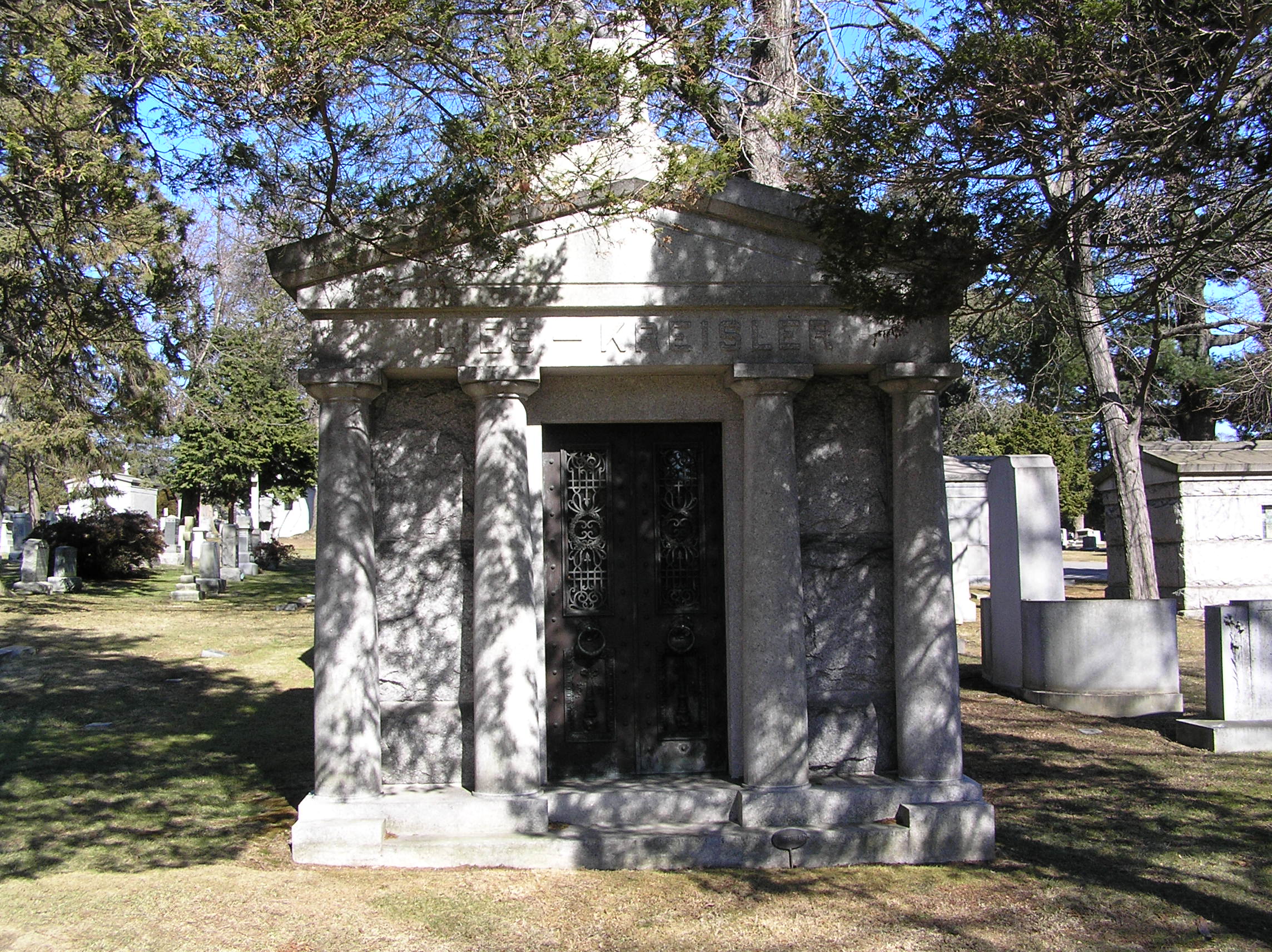
Known for his cheerful and approachable demeanor, Kreisler was also notably generous, often giving his valuable instruments to young, struggling musicians. He was an avid collector of instruments and art. While he sold most of his collection after retirement, he retained the original manuscripts of Johannes Brahms's Violin Concerto and Ernest Chausson's Poème, which he later donated to the Library of Congress in Washington, D.C.. He primarily used a Guarneri del Gesù violin for his performances. He also owned a Jean-Baptiste Vuillaume violin of 1860, which he often used as his second violin, and which he often loaned to the young prodigy Josef Hassid.
3. Violin Performance Career
Fritz Kreisler's career as a violinist was marked by a rapid ascent to international fame, a distinctive and influential playing style, and numerous memorable performances and collaborations.
3.1. Debut and Rise to Fame
Kreisler's professional career began with his United States debut in New York City in 1888, followed by a tour with pianist Moriz Rosenthal. Despite a temporary hiatus for military service and medical studies, his return to the stage in 1899 with the Berlin Philharmonic under Arthur Nikisch propelled him to international recognition. This pivotal concert, praised by luminaries like Eugène Ysaÿe, was followed by successful American tours from 1901 to 1903 and his London debut in 1902, firmly establishing him as a leading violinist of his generation.
3.2. Performance Style and Technique
Kreisler's playing style was highly distinctive and immediately recognizable. It was characterized by a remarkably sweet and warm tone, expressive phrasing, and a unique combination of marked portamento and rubato. He was a pioneer in the use of continuous vibrato, a technique that became a standard for subsequent generations of violinists. While his style drew elements from the Franco-Belgian violin school, it also evoked the cozy and charming `gemütlichgemütlichGerman` lifestyle of pre-war Vienna. His approach emphasized expansive tempi and a melodic treatment of passage-work, making even technical sections sing.
3.3. Key Performances and Collaborations
A highlight of Kreisler's career was the premiere of Sir Edward Elgar's Violin Concerto in 1910, a monumental work specifically commissioned for and dedicated to him. Throughout his career, he collaborated with many of the era's most esteemed musicians, both in live performances and recordings.
Notable collaborations include:
- Pianist Sergei Rachmaninoff, with whom he recorded Edvard Grieg's Violin Sonata No. 3 in C minor, Ludwig van Beethoven's Violin Sonata No. 8 in G major, and Franz Schubert's Violin Sonata No. 5 in A major. Rachmaninoff also dedicated his Variations on a Theme of Corelli to Kreisler and arranged Kreisler's "Liebesfreud" and "Liebesleid" for solo piano.
- Conductor John Barbirolli, leading the London Philharmonic Orchestra and London Symphony Orchestra in recordings of Beethoven's and Johannes Brahms's Violin Concertos.
- Conductor Leo Blech, with the Berlin State Opera Orchestra, for recordings of Beethoven's, Brahms's, and Felix Mendelssohn's Violin Concertos.
- Violinist Efrem Zimbalist, with whom he recorded Johann Sebastian Bach's Concerto for Two Violins.
- Pianist Franz Rupp for Beethoven's Violin Sonata No. 9.
- Conductor Landon Ronald with the London Symphony Orchestra for Mozart's Violin Concerto No. 4 and Mendelssohn's Violin Concerto.
- Conductor Eugene Ormandy and the Philadelphia Orchestra for a recomposed version of Niccolò Paganini's Violin Concerto No. 1.
- Conductor Donald Voorhees with the RCA Victor Orchestra for the C major Violin Concerto attributed to Vivaldi (composed by Kreisler).
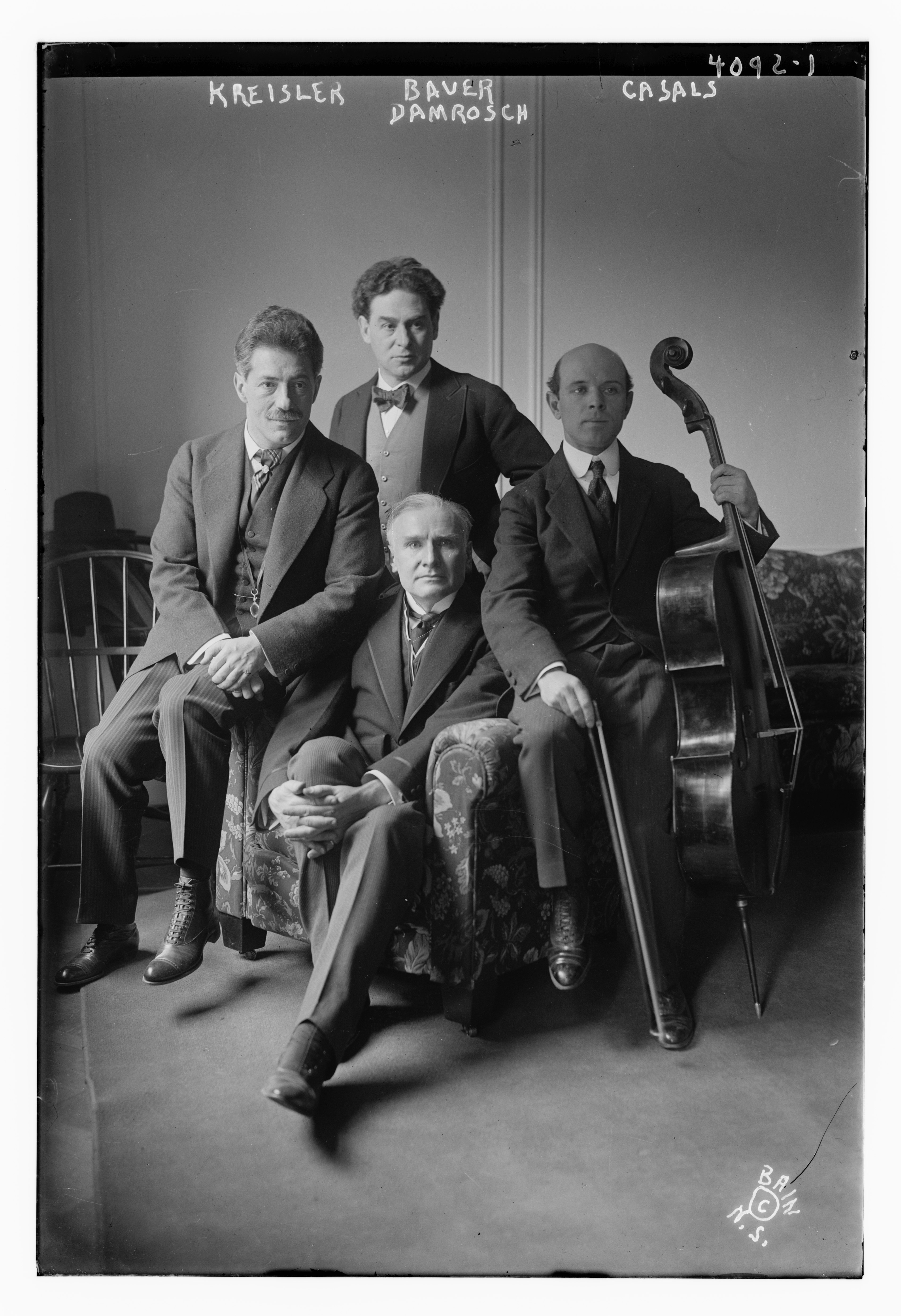
4. Compositions and Musical Works
Beyond his virtuoso performances, Fritz Kreisler was a prolific composer, creating a body of original works, famously crafting pastiches, and contributing significantly to the violin repertoire through his cadenzas and arrangements.
4.1. Original Compositions
Kreisler composed numerous pieces for the violin, many of which became popular encores and staples of the violin repertoire. Among his most famous original compositions are the "Three Old Viennese Dance Melodies" (1905), which include:
- "Liebesfreud" (Love's Joy)
- "Liebesleid" (Love's Sorrow)
- "Schön Rosmarin" (Lovely Rosemary)
Other notable original works for violin include:
- Caprice Viennois, Op. 2
- Tambourin Chinois, Op. 3
- Old Refrain (originally by Johann Brandl)
- La Gitana (Gypsy Woman), composed in 1917 after an 18th-century Arabo-Spanish Romani song.
- Syncopation
- Clown's Serenade
- Viennese Miniature March
- Recitativo and Scherzo-Caprice, Op. 6
- Romantic Lullaby, Op. 9
- Toy Soldier's March
- Praying Woman
- Rondino on a Theme by Beethoven
- Shepherd's Madrigal
- Aucassin and Nicolette
- Viennese Folk Song (from Old Stefan Sturm)
- Two Russian Folk Song Paraphrases (Volga Boatmen's Song, Eikora and Folk Song)
- Londonderry Air (an arrangement of the Irish folk song)
4.2. Pastiches and Musical Hoaxes
One of the most intriguing aspects of Kreisler's compositional output was his practice of creating pieces in the style of earlier composers and attributing them to those masters. He would present these works as "rediscovered" compositions from historical libraries or churches. The most famous instance of this occurred in 1935 when Kreisler publicly revealed that a number of works he had long performed and published, ostensibly by composers such as Gaetano Pugnani, Giuseppe Tartini, and Antonio Vivaldi, were, in fact, his own compositions.
The revelation, published in The New York Times on February 8, 1935, caused a sensation and sparked considerable controversy. When critics expressed their indignation, Kreisler famously responded, "The name changes, the value remains," implying that the compositions' artistic merit was independent of their attributed authorship. He justified his actions by stating that he believed audiences would tire of hearing only his own works, and that other violinists might be hesitant to perform pieces explicitly bearing his name.
The pieces involved in this "musical hoax" include:
- Violin Concerto in C major (attributed to Antonio Vivaldi, RV Anh. 62)
- Scherzo (attributed to Carl Ditters von Dittersdorf)
- Allegretto (attributed to Luigi Boccherini)
- Andantino (attributed to Giovanni Battista Martini)
- Preghiera (attributed to Giovanni Battista Martini)
- La Chasse (Caprice) (attributed to Jean Baptiste Cartier)
- Menuett (attributed to Nicola Porpora)
- Praeludium and Allegro (attributed to Gaetano Pugnani)
- Tempo di Minuetto (attributed to Gaetano Pugnani)
- Sicilienne and Rigaudon (attributed to François Francœur)
- Tambourin (attributed to Jean-Marie Leclair)
- Grave (attributed to Wilhelm Friedemann Bach)
- Chanson Louis XIII and Pavane (attributed to Louis Couperin)
- Aubade Provençale (attributed to Louis Couperin)
- La Précieuse (attributed to Louis Couperin)
- Study on a Choral (attributed to Johann Stamitz)
- Variations on a Theme by Corelli (attributed to Giuseppe Tartini)
While some accused Kreisler of misleading the public for over three decades, others acknowledged that his actions inadvertently sparked a renewed interest in Baroque music and led to the "rediscovery" of many genuine works from that period. It is important to note that the controversy primarily concerned his "arrangements" of Baroque-era works, not his arrangements of Classical or Romantic compositions, which were genuine transcriptions.
4.3. Cadenzas and Arrangements
Kreisler made significant contributions to the standard violin concerto repertoire through his original cadenzas. His cadenzas for the Beethoven Violin Concerto in D major, Op. 61, are particularly notable and remain the most frequently performed by violinists today. He also composed cadenzas for the Brahms Violin Concerto in D major, Op. 77, and Niccolò Paganini's Violin Concerto No. 1 in D major, Op. 6.
Beyond his original compositions and pastiches, Kreisler was a master arranger. He extensively arranged and edited works by a wide range of composers, including Arcangelo Corelli, Johann Sebastian Bach, Wolfgang Amadeus Mozart, Robert Schumann, Felix Mendelssohn, and Antonín Dvořák. His arrangement of the first movement of Paganini's D major Violin Concerto is a prime example of his creative approach, where he rescored, reharmonized, and completely rewrote parts of the orchestral introduction, giving the movement the character of a late-19th-century work.
4.4. Operettas and Other Genres
Kreisler's compositional talents extended beyond solo violin pieces. He composed several operettas, including:
- Apple Blossoms (1919/1920)
- Sissy (1932)
- Rhapsody (1944)
He was also a featured composer for specific pieces in revues, such as "Caprice Viennois" and "La Gitana" in Continental Varieties (1934), and "Stars in Your Eyes" in Reunion in New York (1940). In chamber music, he composed a String Quartet in A minor. Additionally, he wrote the music for the 1936 film The King Steps Out, directed by Josef von Sternberg, which was based on the early life of Empress Elisabeth of Austria.
5. Recordings
Fritz Kreisler's extensive recording career preserved his unique artistry for future generations, allowing his distinctive style and interpretations to be studied and appreciated long after his final performances.
5.1. Recording Career
Kreisler had an extensive recording career, primarily with Victor/RCA Victor and HMV. His recorded output was considerable, and many of his recordings have been reissued on both LP and CD. His final recordings were made in 1950, marking the end of a prolific period of capturing his performances.
5.2. Notable Recordings
Kreisler's discography includes significant recordings of major violin concertos, sonatas, and his own compositions and arrangements. These recordings often feature his distinctive cadenzas or arrangements.
- Johann Sebastian Bach Concerto for Two Violins in D minor, BWV 1043, with Efrem Zimbalist (second violin) and a string quartet (recorded January 4, 1915).
- Ludwig van Beethoven Violin Concerto in D major, Op. 61, with Leo Blech conducting the Berlin State Opera Orchestra (recorded December 15, 1926).
- Beethoven Violin Concerto in D major, Op. 61, with John Barbirolli conducting the London Philharmonic Orchestra (recorded June 16, 1936).
- Beethoven Violin Sonata No. 8 in G major, Op. 30, No. 3, with Sergei Rachmaninoff, piano (recorded March 22, 1928).
- Beethoven Violin Sonata No. 9 in A major, Op. 47, with Franz Rupp, piano (recorded June 17-19, 1936).
- Johannes Brahms Violin Concerto in D major, Op. 77, with Leo Blech conducting the Berlin State Opera Orchestra (recorded November 21, 1927).
- Brahms Violin Concerto in D major, Op. 77, with John Barbirolli conducting the London Symphony Orchestra (recorded June 18, 1936).
- Edvard Grieg Sonata No. 3 in C minor, Op. 45, with Sergei Rachmaninoff, piano (recorded December 14-15, 1928).
- Felix Mendelssohn Violin Concerto in E minor, Op. 64, with Leo Blech conducting the Berlin State Opera Orchestra (recorded December 9, 1926).
- Mendelssohn Violin Concerto in E minor, Op. 64, with Landon Ronald conducting the London Symphony Orchestra (recorded April 8, 1935).
- Wolfgang Amadeus Mozart Violin Concerto No. 4 in D major, K. 218, with Landon Ronald conducting the London Symphony Orchestra (recorded December 1, 1924).
- Niccolò Paganini Violin Concerto No. 1 in D major, Op. 6 (recomposed by Kreisler), with Eugene Ormandy conducting the Philadelphia Orchestra (recorded December 13, 1936).
- Franz Schubert Sonata No. 5 in A major, D. 574, with Sergei Rachmaninoff, piano (recorded December 20, 1928).
- Violin Concerto in C major, RV Anh. 62 (composed by Kreisler, attributed to Antonio Vivaldi), with Donald Voorhees conducting the RCA Victor Orchestra (recorded May 2, 1945).
6. Legacy and Evaluation
Fritz Kreisler's legacy extends far beyond his recorded performances, encompassing his profound influence on violin playing, the complex reception of his compositional practices, and the lasting tributes to his artistry.
6.1. Musical Influence
Kreisler's impact on the art of violin performance was profound. He is credited with popularizing, if not pioneering, the continuous vibrato technique, which became a standard practice for subsequent generations of violinists. His signature playing style, characterized by a sweet, warm tone, expressive phrasing, and extensive use of portamento and rubato, created a unique sound that was instantly recognizable and widely admired. He influenced not only performance technique but also the repertoire, through his original compositions, cadenzas, and arrangements, many of which became staples for violinists worldwide.
6.2. Critical Reception and Public Image
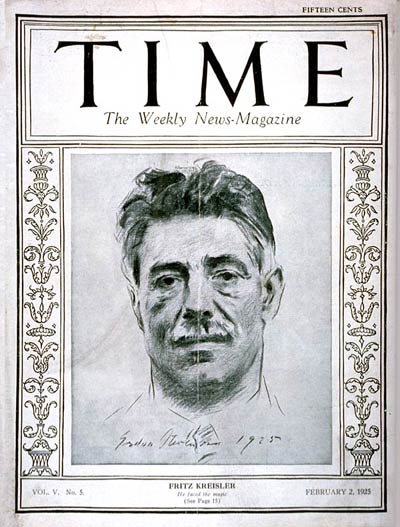
Kreisler was highly praised by both audiences and fellow musicians for his warm, unique violin tone and his exceptional artistry. His concerts were immensely popular, as evidenced by his 1923 tour of Japan, where his performances commanded higher ticket prices than those of his contemporaries, including Mischa Elman and Efrem Zimbalist. For instance, a special seat for a Kreisler concert cost 15 JPY, compared to 7 JPY for Willy Burmester and 10 JPY for Jascha Heifetz, at a time when a university graduate's starting salary was around 50 JPY.
| Violinist | Special Seat Price (1923 JPY) |
|---|---|
| Fritz Kreisler | 15 JPY |
| Willy Burmester | 7 JPY |
| Jascha Heifetz | 10 JPY |
However, his career was also marked by the controversy surrounding his "musical hoaxes." While some critics and the public felt deceived by his attribution of his own compositions to earlier masters, others eventually accepted his artistic intentions, acknowledging that his "rediscoveries" had the positive effect of rekindling interest in Baroque music.
Anecdotes further shaped his public image. The Australian electronics and consumer goods manufacturer Kriesler (later a subsidiary of Philips) is said to have intentionally misspelled its name to avoid potential legal issues, implying a connection to Fritz Kreisler's fame. Literary figures also took note of him; a trip to a Kreisler concert is recounted in Siegfried Sassoon's 1928 autobiographical novel Memoirs of a Fox-Hunting Man.
Kreisler himself offered notable evaluations of other violinists:
- Of Jascha Heifetz, he remarked, "My ultimate achievement is his starting line, from which he extends the record infinitely." He also famously told Efrem Zimbalist, upon hearing Heifetz for the first time, "You and I might as well break our violins over our knees."
- He lauded the short-lived prodigy Josef Hassid, stating, "A world-renowned violinist is born every 100 years, but a Hassid is born every 200 years."
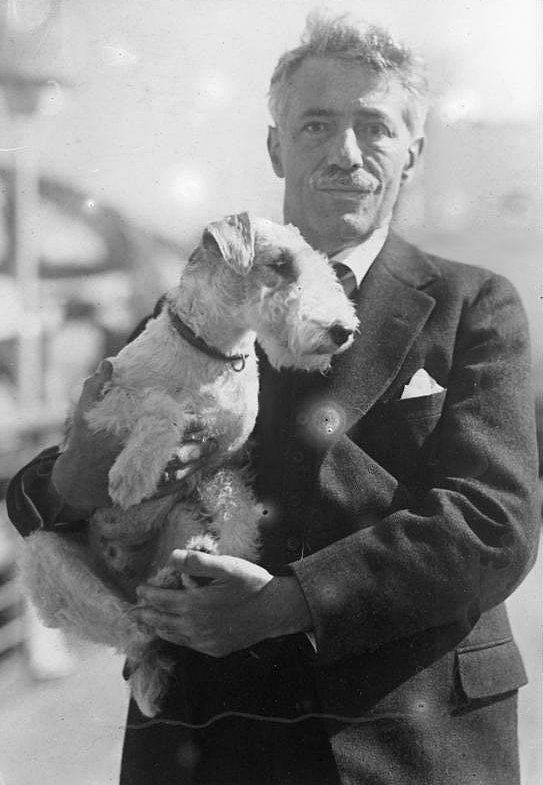
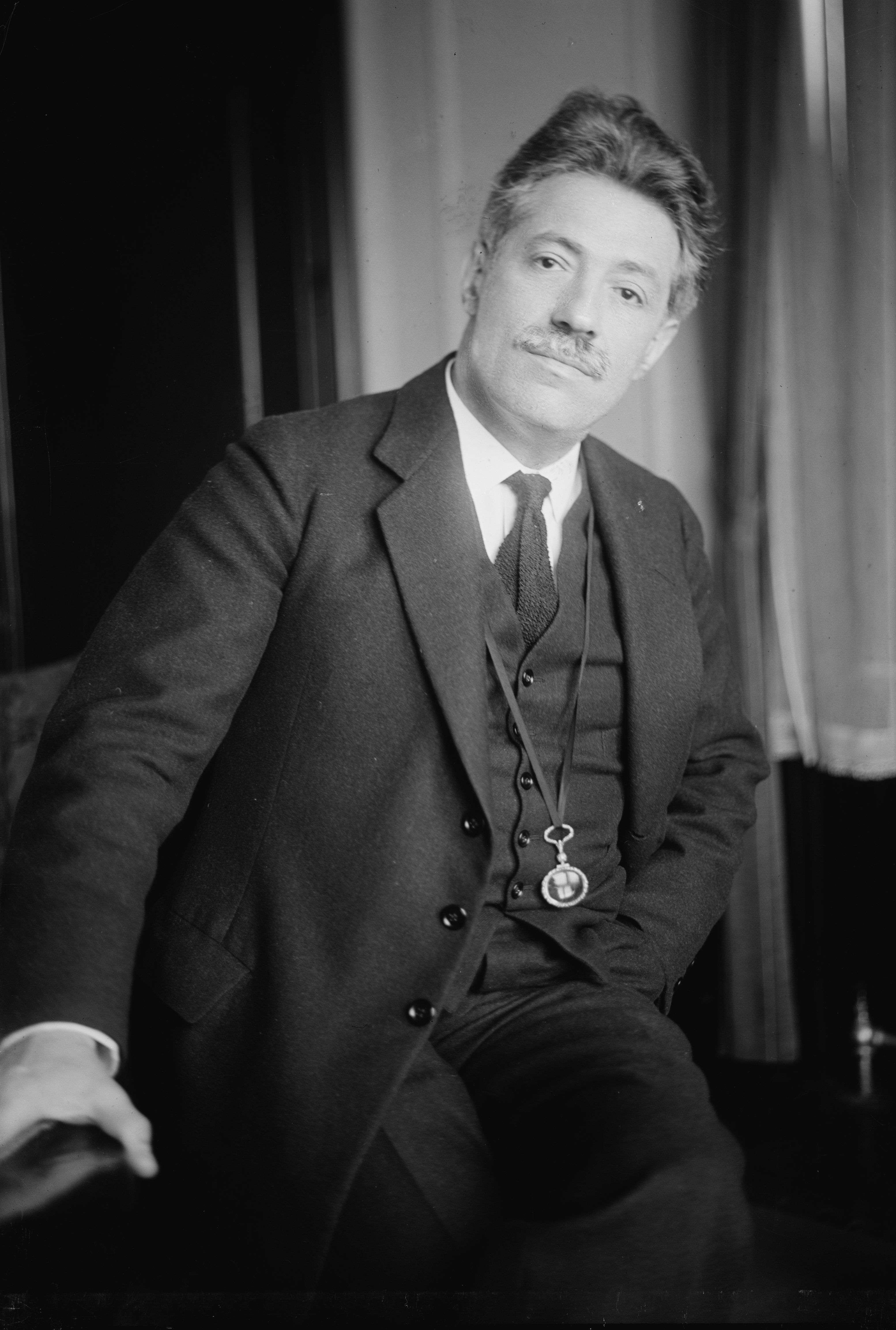
6.3. Tributes and Commemorations
Kreisler's generosity extended to his valuable collection of instruments. In 1952, he donated his Giuseppe Guarneri violin, known as the "Kreisler," to the Library of Congress in Washington, D.C., where it remains in use for performances held at the library. He also donated the original manuscripts of Johannes Brahms's Violin Concerto and Ernest Chausson's Poème to the Library of Congress. These donations serve as enduring testaments to his commitment to music and his philanthropic spirit. The International Fritz Kreisler Violin Competition is held in Vienna, honoring his legacy and fostering new violin talent.
7. Writings
7.1. Autobiography
Fritz Kreisler authored a memoir titled Four Weeks in the Trenches, published in 1915. This book documents his personal experiences during his brief but impactful military service as an officer in the Austro-Hungarian Army during World War I. It offers a unique insight into his time on the Eastern Front and his reflections on the conflict.
8. External Links
- [https://www.allmusic.com/artist/fritz-kreisler-mn0000085189 Fritz Kreisler at AllMusic]
- [https://www.gutenberg.org/ebooks/author/3773 Works by Fritz Kreisler at Project Gutenberg]
- [https://archive.org/search.php?query=creator%3A%22Fritz+Kreisler%22 Works by Fritz Kreisler at Internet Archive]
- [https://librivox.org/author/5362 Works by Fritz Kreisler at LibriVox]
- [https://imslp.org/wiki/Category:Kreisler,_Fritz Scores by Fritz Kreisler at the International Music Score Library Project (IMSLP)]
- [https://web.archive.org/web/20171006223744/http://www.carlfischer.com/composer/kreisler-fritz/ Fritz Kreisler's page at Carl Fischer]
- [http://hdl.handle.net/1802/5482 An assembled edition of original pieces and arrangements for violin and piano] by Fritz Kreisler. From Sibley Music Library Digital Scores Collection
- [http://www.editionsilvertrust.com/kreisler-string-quartet.htm Fritz Kreisler String Quartet in A minor Soundbites & discussion of work]
- [https://adp.library.ucsb.edu/names/103033 Fritz Kreisler recordings] at the Discography of American Historical Recordings.
- [https://www.loc.gov/jukebox/artists/detail/id/1122 Recordings of Fritz Kreisler] on the Library of Congress jukebox
- [http://www.fritzkreisler.com/index.php?lang=en The International Fritz Kreisler Violin Competition]